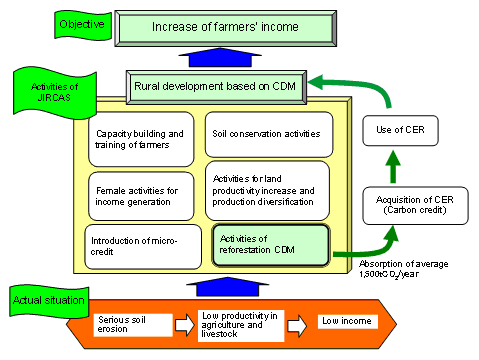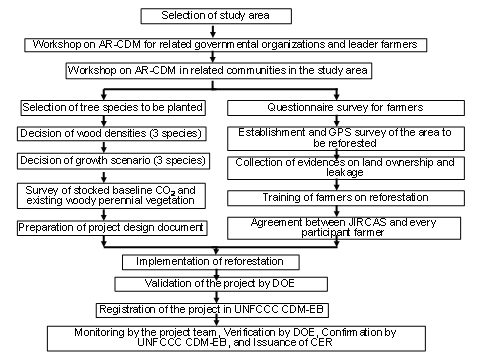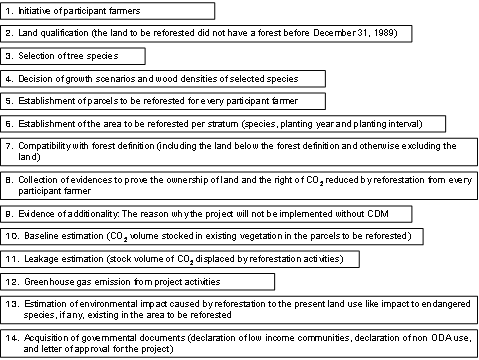The world’s first rural development project based on Afforestation and Reforestation CDM
Description
The Clean Development Mechanism (CDM) is a system which aims to reduce greenhouse gases through the implementation of emission reduction projects in developing countries and by converting the reduced emission volume into credits (Certified Emission Reduction: CER) to be sold to developed countries (Annex I countries in the Kyoto Protocol). The methodology, which practically applies the methods established by the United Nations Framework Convention on Climate Change (UNFCCC) in order to implement a small scale reforestation CDM project in Paraguay, and then registers the project with the UNFCCC CDM-EB (CDM Executive Board) in order to obtain CERs, has been developed in order to ensure the sustainability of rural development by introducing CDM as part of rural development activities.
The execution and registration of the Reforestation CDM project implemented in the selected two cities and 16 communities in Paraguarí Department, Paraguay, where plenty of small scale farmers live and which has the sixth lowest average income in the country, was realized within a series of activities such as: (1) Changing farmers’ awareness through participative approach, (2) Preparation of the Farm Development Plan (plan integral de la finca: PIF) by the farmers themselves, (3) Organizing farmers’ groups in every common income-generating activity described in the PIF, (4) Implementing income-generating activities with cost-sharing between JIRCAS and the farmers, (5) CDM activities by the Reforestation group, (6) Implementation of the CDM project, (7) Utilization of CERs for rural development.
In order to obtain the registration of the CDM project with the UNFCCC CDM-EB, it is necessary to fulfill all the requirements such as growth scenario of every planted tree species, baseline scenario (estimation of present and future growth of CO2 stock in existing vegetation in the reforestation area), leakage (estimation of CO2 emission from crops and livestock replaced by reforestation), land qualification (verification of reforestation in the land whether it complies with the definition of forest as defined in the host country and evidence to prove that the reforested land has had no forest since the end of 1989), Certificate of land ownership, proof of additionalities, appropriateness of monitoring method, etc. as well as appropriate governmental documents, results of on-site surveys and scientific literatures , then finally the facts and documents shall be verified through validation work conducted by the designated operational entity (DOE) accredited by the UNFCCC CDM-EB. For the Reforestation CDM project, data collection on the estimation of baseline scenario and leakage, proofs of land qualification and clarification of land ownership are extremely difficult to obtain due to the lack of basic data in the host country.
In compliance, JIRCAS has established a nursery, estimated the baseline scenario for every participant farmer, prepared the Reforestation Plan (tree species, planting year and interval /agroforestry method), acquired governmental documents (definition of forest, declaration of low income communities, etc.), documentations of land ownership and agreements on the delineation of rights to the CO2 absorbed through the study between JIRCAS and the individual farmers. In addition, JIRCAS has prepared the Project Design Document (PDD), trained farmers on reforestation technology and distributed seedlings to the farmers who planted these on their own. By 2008, JIRCAS has finished the reforestation, jointly with the farmers, of up to 215 ha in 240 plots owned by 167 farmers.
The prepared PDD was validated by the DOE and comments pointed out to be clarified or corrected by the DOE were resolved by supplemental surveys and document acquisition. Thereafter, JIRCAS obtained the Letter of Approval (LOA) from the Paraguayan Government in November of 2008 and from the Japanese Government in March of 2009. The issuance of the registration of the project with UNFCCC CDM-EB, as the first Afforestation and Reforestation CDM project in the world (AR-CDM) which contributes to rural development, is expected in September, 2009.
The extension of rural development based on AR-CDM is anticipated in other areas of Paraguay where serious soil erosion and soil fertility deterioration are occurring due to agricultural overexploitation in spite of abundant land resources, as well as in areas of other South American countries which exhibit similar conditions as the project area, through the distribution of guidelines and manuals prepared in the study, in addition to the demonstration of the AR-CDM project in the experimental and demonstration farms of JIRCAS.
Follow-up of project activities during the project period is important because the CERs shall only be issued in accordance with the measured volume of accumulated CO2 in the reforested areas after the completion of monitoring activities and verification of monitoring results by the DOE and UNFCCC CDM-EB.
Figure, table
-
Fig. 1. Study concept. -
Fig. 2. Flow of the study. -
Fig. 3. Requirements for small scale AR-CDM
- Affiliation
-
Japan International Research Center for Agricultural Sciences Rural Development Planning Division
- Classification
-
Technical B
- Term of research
-
FY2008(FY2008~2010)
- Responsible researcher
-
MATSUBARA Eiji ( Rural Development Planning Division )
KIMURA Kenichiro ( Rural Development Planning Division )
HANANO Tomio ( National University of Asunción )
- ほか
- Publication, etc.
-
Japan International Research Center for Agricultural Sciences(2009)クリーン開発メカニズムの仕組みを活用した農村開発手法の開発報告書
- Japanese PDF
-
2008_seikajouhou_A4_ja_Part2.pdf465.02 KB



